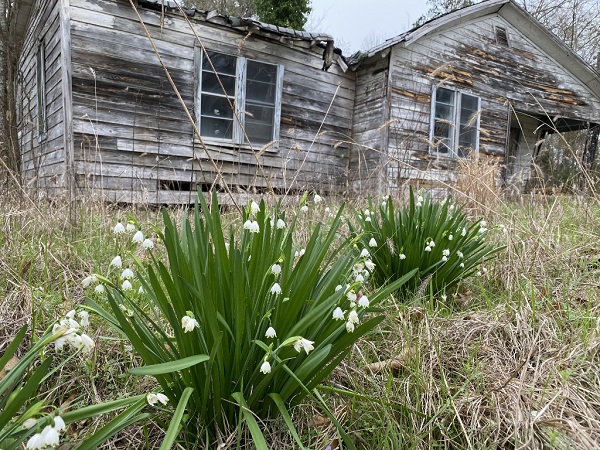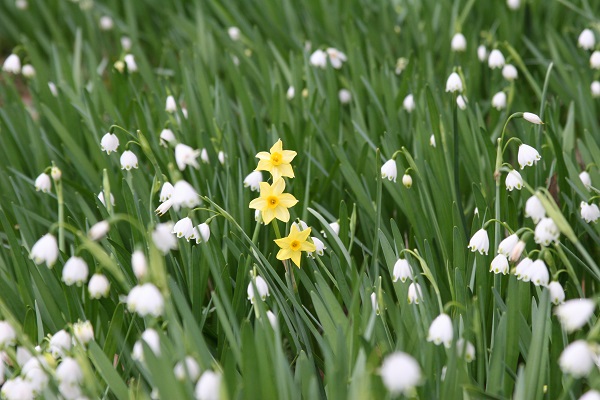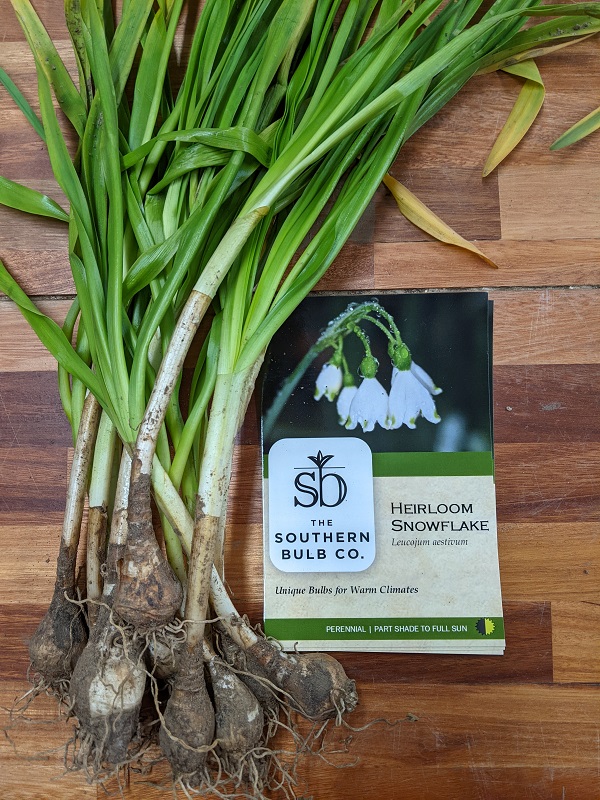


October 2024 - The summer snowflake, or Leucojum aestivum, has been named the latest Texas Superstar plant based on the plant’s proven ability to deliver springtime blooms without any fuss. To be designated a Texas Superstar, a plant must perform well for growers throughout the state. Texas Superstars must also be easy to propagate, ensuring the plants are widely available and reasonably priced. - Texas A&M Agrilife magazine
Termed "Snowflakes" by the gardening public, the Leucojum aestivum is by far one the most adaptable bulbs ever offered in the South. This is the bulb that we suggest people try when they aren't sure if they can grow perennial bulbs. During a season when people only consider daffodils to be early spring bloomers, this unusual bloom will steal your heart and captivate your attention. This diminutive bloom was once prized and plentiful in old southern gardens.

Bulbs often have similar names. The buyer often assumes that the bulbs are the same but just from different companies. Over the years, the Galanthus spp. "Snowdrops" is assumed to be the same as the heirloom Leucojum aestivum "Snowflakes". Though they sound like they should be the same bulb, and the blooms do look similar, it doesn't take long in the warmer areas of the south to realize that they aren't the same. The Snowdrops just can't endure over the years the hot dry summers of the south. Whereas, the heirloom "Snowflakes" actually thrive and exceed expectations. We have even more information about the Leucojum aestivum on our blog, www.bulbhunter.com.




Animals: The pollinators truly enjoy this bloom and make good use of it in early March. If you want a bulb that is resistant to deer and other critters, this is a great one for you. Our Snowflakes have even resisted the munching of goats, so we feel fairly comfortable recommending them to you as an animal-resistant bulb.

Once, when speaking to a garden club in Monroe, a long time member of the club decided that she would like to show me her little patch of snowflakes. I often have such an invitation and see nice little clumps here and there in a garden setting. A surprise was in store for me when we turned onto her property and a field of white met our eyes!

In the summer and fall, we ship dry bulbs that many consumers are familiar with. However, in the spring we ship some flower bulbs with their foliage still on them, having dug them right after their bloom. When the customer receives them, the foliage is in the process of drying down naturally. Plant the bulbs, with foliage and all in the ground and let the foliage turn brown and die back naturally. Another option is to not plant the flower bulbs and store the bulbs with the foliage in a cool, dark, and well ventilated spot, and most importantly let the foliage die down naturally. In other words, DON'T cut the foliage of bulbs when you receive them in the green. The browning and dying back of the foliage is the natural process of the bulb sending food and energy from the leaves down into the bulbs for their summer dormancy.
I thought spring-blooming bulbs are normally shipped in the fall? We grow many of our own snowflake bulbs here on our farm, and while it is unconventional in the United States, it is common to have bulbs shipped in the green in other parts of the world. We grow many of our own heirloom daffodils that we originally collected from old gardens on former homesites. Shipping these in the green allows us to:
1) Ship them during the bloom season when most gardeners are thinking of and remembering to plant snowflakes
2) Ensures correct identification of the flower bulb. These are heirlooms and buying and receiving the right genetic selections is important to having varieties that are perennials and will naturalize in your garden
3) Allows us to offer more bulbs are lower prices to customers
Remember that bulbs shipped in the green are coming to an end of their growth cycle. You can expect:
1) The foliage to yellow and die down naturally
2) The bulb to be dormant in the summer and early fall
3) Roots to start growing in mid fall
4) Foliage appears next January
5) Bulbs to bloom next February and March

October 2024 - The summer snowflake, or Leucojum aestivum, has been named the latest Texas Superstar plant based on the plant’s proven ability to deliver springtime blooms without any fuss. To be designated a Texas Superstar, a plant must perform well for growers throughout the state. Texas Superstars must also be easy to propagate, ensuring the plants are widely available and reasonably priced. - Texas A&M Agrilife magazine
Termed "Snowflakes" by the gardening public, the Leucojum aestivum is by far one the most adaptable bulbs ever offered in the South. This is the bulb that we suggest people try when they aren't sure if they can grow perennial bulbs. During a season when people only consider daffodils to be early spring bloomers, this unusual bloom will steal your heart and captivate your attention. This diminutive bloom was once prized and plentiful in old southern gardens.

Bulbs often have similar names. The buyer often assumes that the bulbs are the same but just from different companies. Over the years, the Galanthus spp. "Snowdrops" is assumed to be the same as the heirloom Leucojum aestivum "Snowflakes". Though they sound like they should be the same bulb, and the blooms do look similar, it doesn't take long in the warmer areas of the south to realize that they aren't the same. The Snowdrops just can't endure over the years the hot dry summers of the south. Whereas, the heirloom "Snowflakes" actually thrive and exceed expectations. We have even more information about the Leucojum aestivum on our blog, www.bulbhunter.com.




Animals: The pollinators truly enjoy this bloom and make good use of it in early March. If you want a bulb that is resistant to deer and other critters, this is a great one for you. Our Snowflakes have even resisted the munching of goats, so we feel fairly comfortable recommending them to you as an animal-resistant bulb.

Once, when speaking to a garden club in Monroe, a long time member of the club decided that she would like to show me her little patch of snowflakes. I often have such an invitation and see nice little clumps here and there in a garden setting. A surprise was in store for me when we turned onto her property and a field of white met our eyes!

In the summer and fall, we ship dry bulbs that many consumers are familiar with. However, in the spring we ship some flower bulbs with their foliage still on them, having dug them right after their bloom. When the customer receives them, the foliage is in the process of drying down naturally. Plant the bulbs, with foliage and all in the ground and let the foliage turn brown and die back naturally. Another option is to not plant the flower bulbs and store the bulbs with the foliage in a cool, dark, and well ventilated spot, and most importantly let the foliage die down naturally. In other words, DON'T cut the foliage of bulbs when you receive them in the green. The browning and dying back of the foliage is the natural process of the bulb sending food and energy from the leaves down into the bulbs for their summer dormancy.
I thought spring-blooming bulbs are normally shipped in the fall? We grow many of our own snowflake bulbs here on our farm, and while it is unconventional in the United States, it is common to have bulbs shipped in the green in other parts of the world. We grow many of our own heirloom daffodils that we originally collected from old gardens on former homesites. Shipping these in the green allows us to:
1) Ship them during the bloom season when most gardeners are thinking of and remembering to plant snowflakes
2) Ensures correct identification of the flower bulb. These are heirlooms and buying and receiving the right genetic selections is important to having varieties that are perennials and will naturalize in your garden
3) Allows us to offer more bulbs are lower prices to customers
Remember that bulbs shipped in the green are coming to an end of their growth cycle. You can expect:
1) The foliage to yellow and die down naturally
2) The bulb to be dormant in the summer and early fall
3) Roots to start growing in mid fall
4) Foliage appears next January
5) Bulbs to bloom next February and March